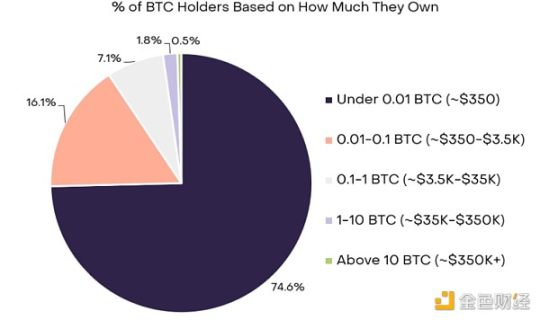Grayscale Reveals Bitcoin Holder Distribution: Only 2.3% of Owners Hold More Than 1 Bitcoin
Source: Grayscale
Compiled by: Song Xue, Golden Finance
- Bitcoin ownership is widely distributed among various groups. 74% of Bitcoin owners hold less than 0.01 Bitcoin.
- Approximately 40% of Bitcoin ownership belongs to identifiable categories, including exchanges, miners, governments, the balance sheets of publicly traded companies, and dormant supply.
- Notably, some of these groups represent "sticky supply," which may amplify the impact of favorable factors related to demand, including the 2024 Bitcoin halving or potential approval of a spot Bitcoin exchange-traded fund (ETF).
As the end of 2023 approaches, two events are imminent: the 2024 Bitcoin (BTC) halving and the potential spot Bitcoin ETF in the United States. Both events could broaden the scope and depth of investor interest in Bitcoin. A common misconception is that a few individuals hold a large amount of Bitcoin. However, this is actually inaccurate. Because the Bitcoin blockchain is transparent, any individual can monitor Bitcoin information in real-time, including its ownership structure. Data from various sources (including Glassnode, Arkham Intelligence, Bitinfocharts, and Bitcoin Treasuries) indicates that Bitcoin supply is widely distributed among various individuals, groups, and organizations around the world.
In this article, Grayscale Research aims to clarify common questions regarding Bitcoin ownership and delve into the implications of various ownership groups. We also discuss the stickiness of Bitcoin supply, why it is particularly important now, and what it means for future assets.
Bitcoin Ownership is Widely Distributed
The vast majority of Bitcoin holders are small investors, as of November 6, 2023, approximately 74% of Bitcoin addresses hold less than 0.01 BTC, worth about $350, as shown in Figure 1. Compared to other historically high-risk, high-return assets (such as private equity and venture capital), which are only available to accredited investors, Bitcoin is accessible to a global retail audience (those with internet access). Therefore, the ownership structure of Bitcoin reflects the decentralized, open-source nature of Bitcoin technology. In fact, only 2.3% of Bitcoin owners hold 1 Bitcoin or more (as of November 6, 2023, each Bitcoin is valued at approximately $35,000).

Figure 1: Distribution of Bitcoin addresses. Note: For ease of viewing, dollar figures are rounded to reflect the value of 1 Bitcoin at $35,000.
In addition to Bitcoin ownership being primarily distributed among multiple small holders, most of the largest Bitcoin holders represent "the majority" rather than a minority. As of November 6, 2023, the top five wallet addresses by Bitcoin holdings are either cryptocurrency exchanges or government entities, as shown in the figure below.

Figure 2: Top 5 Bitcoin wallet addresses by balance. Note: Exchanges typically hold multiple wallets/addresses, which is why Binance appears multiple times here. Source: Bitinfocharts, Grayscale Investments. Data as of November 14, 2023, in USD and holdings. The Bitcoin price in this chart is equal to $36,891.
Notably, exchange addresses like Binance and Robinhood represent millions of individuals. For example, Robinhood has 11 million users on its platform who own and trade Bitcoin each month, while Binance, one of the largest cryptocurrency exchanges in the world, has nearly 90 million monthly active users. Additionally, the aforementioned U.S. government addresses represent institutional ownership rather than individual ownership.
Bitcoin holders include a variety of institutions ranging from exchanges to publicly traded companies to major governments. Although some members of these groups may overlap with others, approximately 40% of the total Bitcoin supply can be attributed to identifiable ownership groups, such as exchanges, government entities, publicly traded companies, and private companies (e.g., Tesla and Block Inc.), mining companies that secure the Bitcoin network, ETFs and other listed funds, wrapped Bitcoin, consumer trading platforms (e.g., Robinhood), and dormant addresses. The following lists these groups.

Figure 3: Identifiable Bitcoin supply. Note: Grayscale's holdings are reflected in the "ETFs and Funds" category. This category includes futures-based products and other funds holding Bitcoin. Source: Bitcoin Treasuries, Arkham Intelligence, Glassnode, Bitinfocharts. Note: There may be some overlap between certain groups (e.g., last active supply from 10 years ago and miners). All data as of November 13, 2023. For illustrative purposes only and may change.
For investors, understanding and analyzing the largest Bitcoin owners and the potential impact of these holders on Bitcoin supply dynamics is crucial.
Some specific ownership categories reflect potential sticky supply dynamics— in other words, owners taking a long-term position in a specific asset. For example, 14% of Bitcoin supply has not changed hands in 10 years. We believe this portion of the supply can be attributed to the original tokens held by Satoshi, lost tokens or addresses, and holders who have held for a decade. As shown below, the decade-long inactive supply has been increasing since 2019 and is currently at an all-time high.

Other ownership groups that seem to indicate relatively stable supply levels include miners and exchanges, which account for 20% of the total supply (approximately 9% and 11%, respectively). As shown in the figure below, despite significant fluctuations in Bitcoin prices over time, these two ownership groups have historically been relatively unaffected by price elasticity. This may be because miners accumulate Bitcoin as rewards over time and typically only sell a portion necessary to cover operational costs. In the past, periods of net outflows from miners, such as in November 2022, had a relatively small impact on the overall miner balance of Bitcoin. This suggests that a significant portion of miners' overall Bitcoin balances may consist of long-term holders. Some degree of price inelasticity in the short term may also extend to other ownership groups, such as wrapped Bitcoin (1.25% of total supply), due to Bitcoin being locked in smart contracts.

So, what does the implication of these ownership groups indicating a lack of price elasticity mean?
In the short term, the relatively different levels of price inelasticity among Bitcoin holders may amplify the impact of favorable factors related to demand. This can be compared to "low float" stocks in traditional financial markets, which represent a lower proportion of company shares that can be traded in the open market. For example, a sudden change in demand for low float stocks, combined with a reduced supply actively traded in the market, may lead to an exaggerated impact on prices. Considering the various inactive or price-inelastic Bitcoin ownership groups, this dynamic may be particularly relevant to Bitcoin.
Conclusion
Bitcoin ownership is distributed and diverse. Furthermore, the presence of respected institutions owning Bitcoin indicates the maturity of the Bitcoin market and an increase in public acceptance and mainstream adoption.
Looking ahead, global political and regulatory developments could significantly impact the ongoing adoption and demand for this asset. For example, the potential U.S. Bitcoin spot ETF could further eliminate friction for individuals and institutions seeking to allocate Bitcoin, while Argentina's recent presidential election may signify a shift in how emerging economies view Bitcoin and other crypto assets. As of November 2023, there are approximately less than six months until the 2024 Bitcoin halving.
Meanwhile, amidst these unfavorable factors related to demand, Bitcoin's supply remains significantly constrained. Illiquid and long-term holders' supply has surged to unprecedented levels, while short-term supply has dropped to its lowest levels. If these trends continue, the Grayscale research team anticipates that the dynamics of Bitcoin ownership may increasingly amplify the impact of macro events, such as changing global policies and regulations (e.g., approval of the U.S. spot Bitcoin ETF) and developments in the cryptocurrency market, such as the 2024 Bitcoin halving.











